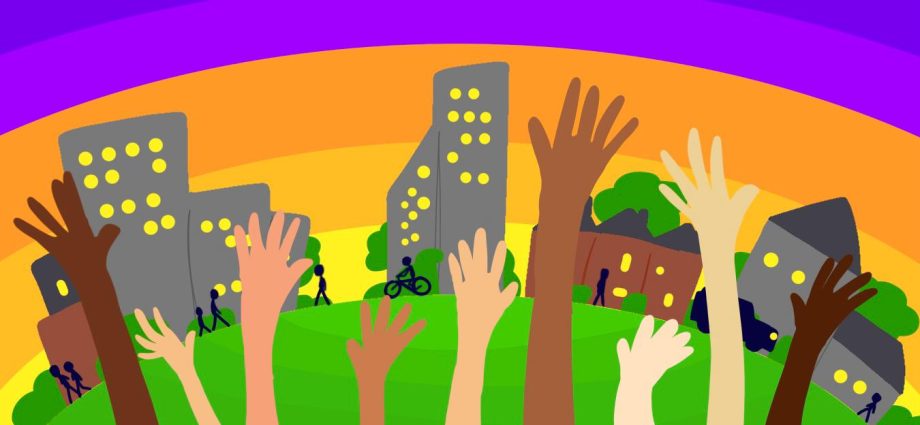Written by Angel Riofrio
How does one build a Sustainable City?
Our times are characterised by issues that concern spatial planning but go way beyond struggles over space. Increased inequalities, aggravated extreme weather events and ever-developing technologies are the results of strict blueprints, social networks and struggles over space. As the development of cities becomes increasingly relevant to global development agendas we must consider how justice, sustainability and participation are defined, and mainly, who gets to define them.
A Sustainable City is one that is described by affordability, access and inclusivity. As tools it utilises the very structures that shape it: power, space, livelihoods and social relations, incorporating even elements of new technologies. This article aims to point at three crucial factors to be considered when one talks of a sustainable city:
* The commons
*Critical data studies
*The politics of care
The Commons: Reclaiming Space and Autonomy
The heart of a Sustainable City is its commons. Commons are resources’ shared, democratic, publicly owned. They take the form of public parks, community gardens, informal housing, and even digital platforms. They are a crucial part of a fair city, as they allow for a space to exist outside of the logic of profit and accumulation, and the inequalities and discrepancies it brings about.
Within a capitalistic socioeconomic system, the commons are under threat. Capitalism seeks to privatise and monetise. Shared spaces are accumulated into the private property of the few. Gentrification, land grabs and commodification are some of the most obvious forms of this practice within modern cities. Space, under capitalism, becomes a vehicle for speculation, displacement, and control.
Within a capitalistic socioeconomic system, the commons must resist. They work as spaces of autonomy, collaboration and survival, especially of the more vulnerable groups. Social, cooperative and public housing must persist to protect those that capitalism ignores. Commoning practices—community-led housing, cooperative economies, collective care—offer counter-models that challenge elite hegemony and envision new forms of urban life.
For a Sustainable City, designers and planners are the ones that must ensure the survival of the commons. Urban planning must insist to hinder their dismantling, and to nurture collective ownership and access. In the face of climate breakdown and social fragmentation, protecting and sustaining the commons is an urgent act of urban resilience.
Critical Data Studies: Justice in the Age of Techno-Solutionism
Spatial planners that are led by values of sustainability emphasize the importance of collective space and governance. In parallel, informed from Critical Data Studies they also promote the questioning of how data and digital technologies shape cities—and who they serve. Smart cities promise efficiency, safety, and sustainability through sensors, surveillance and predictive analytics. Yet beneath these techno-utopian narratives lies a deeper question: Whose data? Whose city?
Critical data science warns of the power dynamics hidden beneath data practices. It highlights that algorithms often reinforce racial and economic inequalities, while surveillance infrastructures sometimes undermine privacy and citizenship. As cities increasingly rely on data-driven governance, the risk is that democratic deliberation is replaced by opaque technical systems.
Of course this doesn’t mean that all technology is bad. The issue lies in how technologies are developed, deployed, and governed. It is crucial for a Sustainable City in the digital age that transparency, accountability, and public participation in technological decision-making are maintained. This requires strict regulation, ethical standards, and rigid commitment to digital rights.
It it crucial that citizens are provided with literacy to understand how data affect their lives. Similarly, municipalities need ethical frameworks to guide utilisation of AI and the development of infrastructure projects. Data justice needs to be integrated into the practice of Urban planners and designers. Equitable access to technology and its fair use has to be certified.
Data are a re-imagined form of power, with overwhelming possibility. Reclaiming this power is necessary, and this can only be done through digital commons: data cooperatives, open-source urban platforms, and participatory tech design that serves public interest, not private capital. A Sustainable City must be both spatially and digitally democratic.
The Politics of Care: Planning Beyond Extraction
If one aims to create a Sustainable City, he definitely has to investigate its position within the global production. A fair city cannot be acquainted with colonial urbanism and extractive development. The Global South consistantly faces the consequences of unequal global systems—drained of resources, shaped by outdated policies and inequalities, and influenced by external agendas. Spatial planning must endorse transparency in global value chains, to ensure that years of exploitation won’t be repeated.
Politics of care is what is to be called for- Politics that take into consideration those that have been harshly exploited by a global production chain. Moving beyond transactional models of development toward relational, decolonial, and ecological planning practices is necessary. For that to be attained, listening to local knowledges is indispensable. We need to refocus on livelihoods and ecosystems that sustain urban life.
We need to remember that sustainability was never just about the planet, it was about the people too. Urban sustainability, when stripped of justice, becomes another form of green-washing. A Sustainable City isn’t just a green city, it’s a fair city.
A Synthesis: Commons, Critical Data, and Care
What brings together the commons, critical data, and care is a shared refusal of urbanism as a tool of domination. Every single one of them questions the concentration of power, whether in elite land ownership, algorithmic systems, or colonial planning regimes. Every single one endorses bottom-up, place-based, and plural approaches to city-making.
A Sustainable City is not a fixed blueprint. It is a political horizon—emerging, contested, and shaped by the everyday struggles of those who dare to imagine otherwise.
Edited by Daria Aron, Illustration by Evie H

